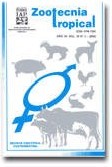
|
Zootecnia Tropical
Instituto Nacional de Investigaciones Agrícolas Venezuela
ISSN: 0798-7269
Vol. 25, No. 4, 2007, pp. 253-259
|
 Bioline Code: zt07038
Bioline Code: zt07038
Full paper language: Spanish
Document type: Research Article
Document available free of charge
|
|
|
Zootecnia Tropical, Vol. 25, No. 4, 2007, pp. 253-259
| en |
Evaluation of the cutting frequency and fertilization types on three elephant grass genotypes ( Pennisetum purpureum  ). 1. Yield and protein content ). 1. Yield and protein content
Márquez, Freddy; Sánchez, José; Urbano, Diannelis & Dávila, Ciro
Abstract
In order to evaluate the effect of the cutting frequency and types of nitrogen fertilization on three elephant grass genotypes, a field trial was carried in the Universidad de Los Andes farm, in El Vigia, Merida state, Venezuela, located at 67 masl. A random bocks design with three replications was used; treatments were two cutting frequencies (F1: 49 and F2: 63 days), three genotypes (G1: Taiwan A-146, G2: Morado, and G3: Maralfalfa) and three types of fertilization (N1: cow manure, equivalent to 91 kg N/ha/year, N2 and N3 urea with 343 and 686 kg N/ha/year). The FxG interaction was significant over pasture yield (TDM) and crude protein (CP). Yields were 40.9, 29.7, and 37.7 t DM/ha/year for G1, G2, and G3, respectively. Dry Matter (DM%) content was different (P<0.01) for FxG, with higher values obtained at F2 (21.5%) and G1 (20.4%). Crude protein content decreased with the regrowth age, and the relation CP = 17.7 - 0.18 x F(days) was estimated. It was concluded that higher yields were obtained with Taiwán A-146 and Maralfalfa with F2 and N2, while high CP content was obtained with Morado elephant grass and F1. Nitrogen fertilization increased forage yield and protein content of the three elephant grass genotypes.
Keywords
elephant grass genotypes, cutting frequency, fertilization, yield, protein.
|
| |
| es |
Evaluación de la frecuencia de corte y tipos de fertilización sobre tres genotipos de pasto elefante ( Pennisetum purpureum  ). 1. Rendimiento y contenido de proteína ). 1. Rendimiento y contenido de proteína
Márquez, Freddy; Sánchez, José; Urbano, Diannelis & Dávila, Ciro
Resumen
Con la finalidad de determinar el efecto de la frecuencia de corte y tipos de fertilización nitrogenada en tres genotipos del pasto elefante, se condujo un ensayo en la finca Judibana, de la Universidad de Los Andes, en El Vigía, estado Mérida, Venezuela, ubicada a 67 msnm. Se utilizó un diseño bloques al azar con tres repeticiones; los tratamientos fueron dos frecuencias de corte (F1: 49 y F2: 63 días), tres genotipos (G1: Taiwan A-146, G2: Morado y G3: Maralfalfa) y tres tipos de fertilizaciones (N1 estiércol de bovinos, equivalente a 91 kg N/ha/año, N2 y N3 urea, correspondiendo a 343 y 686 kg N/ha/año, respectivamente). El efecto FxG influyo significativamente sobre el rendimiento de materia seca total (MST) y proteína cruda (PC). Los rendimientos fueron 40,9, 29,7 y 37,7 t MS/ha/año para G1, G2 y G3, respectivamente. En relación con el porcentaje de materia seca, se detectaron diferencias (P<0,01) para FxG, logrando los mayores valores (21,5%) en F2 y con G1 (20,4%). El contenido de proteína cruda disminuyó con la edad de los rebrotes, estimándose la relación PC = 17,7 - 0,18 x F(días). Se concluye que los mayores rendimientos de materia seca se lograron con Taiwan A-146 y Maralfalfa con la F2 y N2, mientras que el mayor contenido de proteína se obtuvo con el pasto morado y la F1. La fertilización con nitrógeno influyó positivamente en la producción de forraje y el contenido proteico de los tres genotipos de pasto elefante.
Palabras-clave
genotipos de pasto elefante, frecuencia de corte, fertilización, rendimiento, proteína.
|
| |
© Copyright 2007 - Zootecnia Tropical
Alternative site location: http://www.sian.inia.gob.ve/repositorio/revistas_ci/ZootecniaTropical/ztindice.htm
|
|
